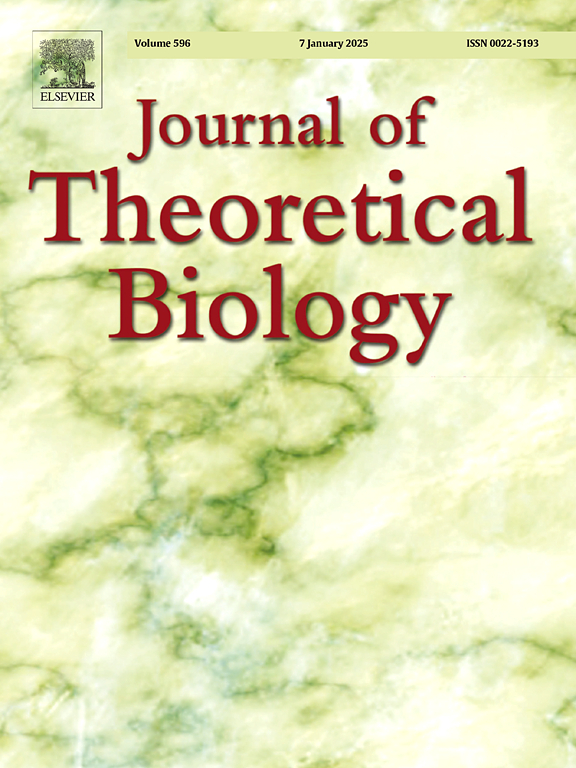Adaptive dynamic resource allocation can cause tragedy of the commons in plants with nutrient competition
IF 2
4区 数学
Q2 BIOLOGY
引用次数: 0
Abstract
Plants exhibit plastic responses to the absence or presence of competitors. When competing for soil nutrients, plants often show root overproliferation compared to when they grow without competitors. This excessive investment in roots to acquire more nutrients can reduce reproductive yield (e.g., seed mass), a phenomenon known as the tragedy of the commons (TOC). The mechanisms of this phenomenon have been investigated theoretically, focusing on resource allocation strategies between the aboveground (shoot) and the belowground (roots) parts. The previous studies have primarily considered these strategies in terms of sizes of those parts or static allocation rates to those over the season, overlooking dynamic change of allocation within the season. In this study, we introduced a concept of dynamic resource allocation into the plant competition game and investigate the optimal resource allocation strategy using Pontryagin’s maximum principle. Based on the solutions of schedules, we explored the mechanism causing TOC in nutrient competition. Our findings reveal that plants adopt the singular control (i.e., simultaneous allocation to shoot and root), where the control trajectory is identical regardless of the presence or absence of competitors, although the period of simultaneous allocation become longer in the presence of competitors. This trend associates with increasing the root size and decreasing the shoot size at the end of season in the competitive case. Our analysis demonstrates that TOC in plant nutrient competition arises from differences in the allocation period to roots in the competitive scenario.
在养分竞争中,植物的适应性动态资源配置会引起公地悲剧。
植物对竞争对手的缺席或存在表现出可塑性反应。在争夺土壤养分时,与没有竞争对手生长时相比,植物往往表现出根系过度增生。这种为获取更多营养而对根系进行的过度投资会降低生殖产量(如种子质量),这种现象被称为公地悲剧(TOC)。这一现象的机制已经从理论上进行了研究,重点是地上部分(茎)和地下部分(根)之间的资源分配策略。以往的研究主要是考虑这些策略在这些部分的大小或静态分配率的季节,忽略了动态变化的分配在季节内。本文将动态资源分配的概念引入植物竞争博弈中,利用庞特里亚金最大值原理研究植物竞争博弈的最优资源分配策略。在此基础上,探讨了养分竞争中TOC产生的机理。研究结果表明,植物采用单一控制(即同时分配给茎和根),无论竞争对手是否存在,控制轨迹都是相同的,尽管竞争对手存在时同时分配的时间更长。这一趋势与竞争条件下季末根粗增加、茎粗减少有关。分析表明,植物养分竞争中的TOC是由竞争情景下分配给根系的时间差异引起的。
本文章由计算机程序翻译,如有差异,请以英文原文为准。
求助全文
约1分钟内获得全文
求助全文
来源期刊
CiteScore
4.20
自引率
5.00%
发文量
218
审稿时长
51 days
期刊介绍:
The Journal of Theoretical Biology is the leading forum for theoretical perspectives that give insight into biological processes. It covers a very wide range of topics and is of interest to biologists in many areas of research, including:
• Brain and Neuroscience
• Cancer Growth and Treatment
• Cell Biology
• Developmental Biology
• Ecology
• Evolution
• Immunology,
• Infectious and non-infectious Diseases,
• Mathematical, Computational, Biophysical and Statistical Modeling
• Microbiology, Molecular Biology, and Biochemistry
• Networks and Complex Systems
• Physiology
• Pharmacodynamics
• Animal Behavior and Game Theory
Acceptable papers are those that bear significant importance on the biology per se being presented, and not on the mathematical analysis. Papers that include some data or experimental material bearing on theory will be considered, including those that contain comparative study, statistical data analysis, mathematical proof, computer simulations, experiments, field observations, or even philosophical arguments, which are all methods to support or reject theoretical ideas. However, there should be a concerted effort to make papers intelligible to biologists in the chosen field.

 求助内容:
求助内容: 应助结果提醒方式:
应助结果提醒方式:


